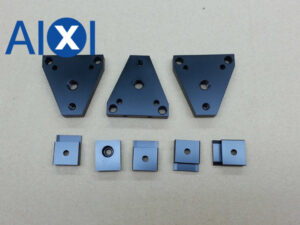Both aluminum anodizing and conductive oxidation are popular processes. Manufacturers use them to get desired properties in aluminum material. However, laymen do not understand these processes well, and many don’t know their differences. This motivated me to write a detailed article on aluminum anodizing vs conductive oxidation.
This article will uncover the key differences between aluminum anodizing and conductive oxidation. Both processes are indeed very technical and hard to understand. So, I will try to explain these two in the easiest possible way. So, let’s get cracking!
Overview of Aluminum Anodizing & Conductive Oxidation
Both of these processes add an oxide layer to the surface of aluminum. However, the aluminum anodizing process adds a non-conductive oxide layer. It means it does not pass electricity. Conversely, conductive oxidation creates a conductive oxide layer (passes electricity).
The aluminum anodizing process creates an oxide layer that is durable and rust-resistant. However, this oxide layer passes no or minimal current through it. This is a big drawback, especially for making electronics-related aluminum parts. You cannot use anodized aluminum to make battery connectors or circuit boards.
In such a case, conductive oxidation comes into play. It creates a thinner oxide layer that can pass electricity (conductive). An acidic solution, generally sulphuric acid, is used in the anodizing process. Aluminum is dipped in this solution, and current is passed through it. As a result, oxidation happens, and oxygen reacts with aluminum to form an oxide layer.
On the flip side, conductive oxidation is a bit different. It does not involve an acidic solution. Instead, aluminum is immersed in oxidants or chemicals under favorable conditions. Those chemicals can be anything like chromates or phosphates. The oxidation process starts in controlled conditions, forcing oxygen to react with aluminum.
This reaction results in a thin, conductive layer on the aluminum surface. Both of these processes have their uses. The anodizing process is helpful when a non-conductive oxide layer is needed. However, conductive oxide consistently achieves an oxide layer with more electrical conductivity. There is no good or bad between these two types.

What Are the Differences Between Aluminum Anodizing and Conductive Oxidation?
Have you got the basics of these processes? In short, they both produce an oxide film on the aluminum surface. However, these processes have many differences.
Among those differences, electrical conductivity remains at the top. Anodizing produces oxide that is little or no conductive of electricity. However, conductive oxidation produces layers with electrical conductivity. However, it is thin, less intense, and has compromised rust resistance.
Apart from this main difference, there are a few more distinctions. Let’s explore the differences between anodizing and conductive oxidation in depth.
1- High Voltage Requirement
Aluminum anodization is carried out under the condition of conductive high voltage. On the flipside, the conductive oxidation does not need to be conductive. It can be immersed in a chemical, which is a chemical reaction. You won’t need external current to carry the reaction. Instead, a chemical reaction happens on its own and creates a thin oxide film. The anodizing process cannot occur without a high-voltage current.
2- Speed of Process
Aluminum anodizing takes a long time, usually half an hour. Moreover, it requires pre-setup, such as an electricity source and acidic solution. On the other hand, conductive oxidation only takes half a minute. The chemical reaction in conductive oxidation is rapid and natural. It completes and creates a thin film in seconds.
3- Thickness of Oxide Film/Layer
The film formed by aluminum anodic oxidation is usually one μm to tens of μm. This thickness of the oxide layer offers strength and durability. Conversely, the film formed by conductive oxidation is only 0.01-0.15 μm. Due to its thickness, it provides compromised wear resistance. However, it offers both conductivity and also resistance to atmospheric corrosion. Remember, the conductivity is because the oxide layer is too thin.
4- Durability & Corrosion Resistance
As mentioned above, the anodizing process creates a dense, thick oxide layer. Due to its thickness, it is strong and does not deteriorate quickly. Even in the harshest conditions, it offers excellent durability. Moreover, its corrosion resistance is far better than the oxide layer made by the conductive oxidation process. The thinness of this layer makes it more fragile and less durable. However, its electrical conductivity makes it stand out.
5- Appearance & Usability
The anodizing process creates a gleaming and aesthetically pleasing oxide layer. Moreover, manufacturers can add dyes to get a colored oxide film. This makes aluminum suitable for making decorative products. Conversely, the conductive oxidation process makes the oxide film less attractive and metallic.
As you know, anodized aluminum is strong and durable, so it can be used in many diverse ways. Many industries make corrosion-resistant products, including aerospace, automobiles, and marine. However, aluminum with a conductive oxidative oxide layer has lesser usability. It is more common in electronics, where conductivity matters the most.
6- Cost & Affordability
The anodizing process is more costly than conductive oxidation. The reason is that it requires a more complex setup. For example, acidic solutions, electricity sources, and rectifiers. Moreover, the duration of oxide formation is also long.
So, it will take more energy for those lengthy oxide formation durations. Conversely, the conductive oxidation process is inexpensive as no setup is required. Moreover, this process creates a thin oxide layer very quickly. It does not need any external energy source. However, this layer is more fragile and less durable.
Conclusion
Keep in mind that both of these processes have unique pros and cons. Their usability is more specific to users’ purposes. For example, go with conductive oxidation if you need electrically conductive aluminum.
Conversely, I recommend choosing the anodizing process for a more durable oxide layer. In the process article, I discuss the difference between regular and anodized aluminum. You should read that article as well. WHY? Because it would help you debunk all the confusion about anodized aluminum.

 Deutsch
Deutsch Français
Français 日本語
日本語 Español
Español
